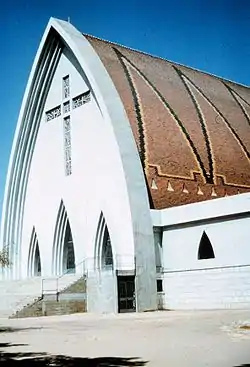Christianity in Chad
Christianity in Chad arrived more recently than other religions, with the arrival of Europeans.[1] Its followers are divided into Roman Catholics and Protestants (including several denominations) and collectively represent 45% of the country's population.[1][2]
| Christianity by country |
|---|
 |
|
|
Protestantism
The Protestants came to southern Chad in the 1920s.[1] The American organization Baptist Mid-Missions was the first Protestant mission to settle in the country in 1925 in Sarh.[3] Missionaries of other denominations and nationalities soon followed.[1] Many of the American missions were northern offshoots of missionary networks founded farther south in the Ubangi-Chari colony (now Central African Republic) of French Equatorial Africa (Afrique Equatoriale Franchise — AEF).[1] The organizational ties between the missions in southern Chad and Ubangi-Chari were strengthened by France's decision in 1925 to transfer Logone Occidental, Tandjilé, Logone Oriental, and Moyen-Chari prefectures to Ubangi-Chari, where they remained until another administrative shuffle restored them to Chad in 1932.[1]
In 1964, the Chadian Association of Baptist Churches was officially founded.[3]
These early Protestant establishments looked to their own churches for material resources and to their own countries for diplomatic support.[1] Such independence allowed them to maintain a distance from the French colonial administration.[1] In addition, the missionaries arrived with their wives and children, and they often spent their entire lives in the region.[1] Some of the missionaries who arrived at that time had grown up with missionary parents in missions founded earlier in the French colonies to the south.[1] Many remained after independence, leaving only in the early and or mid-1970s when Tombalbaye's authenticité movement forced their departure.[1]
The missionaries set up schools, clinics, and hospitals long before the colonial administration did.[1] In fact, the mission schools produced the first Western-educated Chadians in the 1940s and 1950s.[1] In general, the Protestant missionary effort in southern Chad has enjoyed some success.[1] In 1980, after a half-century of evangelization, Protestants in southern Chad numbered about 80,000.[1]
From bases in the south, Protestants founded missions in other parts of Chad.[1] In the colonial capital of Fort-Lamy (present-day's N'Djamena), the missions attracted followers among resident southerners.[1] The missionaries also worked among the non-Muslim populations of Guéra, Ouaddaï, and Biltine prefectures.[1] There were estimated to be 18,000 Christians in N'Djamena in 1980.[1]
Roman Catholicism

The Roman Catholic missions came to Chad later than their Protestant counterparts.[1] Isolated efforts began as early as 1929 when The Holy Ghost Fathers from Bangui founded a mission at Kou, near Moundou in Logone Occidental Prefecture.[1] In 1934, in the midst of the sleeping sickness epidemic, they abandoned Kou for Doba in Logone Oriental Prefecture.[1] Other priests from Ubangi-Shari and Cameroon opened missions in Kélo and Sarh in 1935 and 1939, respectively.[1]
In 1946 these autonomous missions gave way to an institutionalized Roman Catholic presence.[1] This late date had more to do with European politics than with events in Chad.[1] Earlier in the century, the Vatican had designated the Chad region to be part of the Italian vicarate of Khartoum.[1] Rather than risk the implantation of Italian missionaries during the era of Italian dictator Benito Mussolini, the French administration discouraged all Roman Catholic missionary activity.[1] For its part, the Vatican adopted the same tactic, not wishing to upset the Italian regime by transferring jurisdiction of the Chad region to the French.[1] As a consequence of their defeat in World War II, however, the Italians lost their African colonies.[1] This loss cleared the way for a French Roman Catholic presence in Chad, which a decree from Rome formalized on March 22, 1946.[1]
This decree set up three religious jurisdictions that eventually became four bishoprics.[1] The first, administered by the Jesuits, had its seat in N'Djamena.[1] Although its jurisdiction included the eight prefectures in the northern and eastern parts of the country, almost all the Roman Catholics in sahelian and Saharan Chad lived in the capital.[1] The diocese of N'Djamena also served as the archdiocese of all Chad.[1] The second bishopric, at Sarh, also was delegated to the Jesuits.[1] Its region included Salamat and Moyen-Chari prefectures.[1] The third and fourth jurisdictions had their headquarters in Pala and Moundou and were delegated to the Oblats de Marie and Capuchin orders.[1] The Pala bishopric served Mayo-Kebbi Prefecture, while the bishopric of Moundou was responsible for missions in Logone Occidental and Logone Oriental prefectures.[1] By far the most important jurisdiction in 1970, Pala included 116,000 of Chad's 160,000 Catholics.[1]
The relatively slow progress of the Roman Catholic Church in Chad has several causes.[1] Although Roman Catholicism has been much more open to local cultures than Protestantism, the doctrine of celibacy probably has deterred candidates for the priesthood.[1] Insistence on monogamy also has undoubtedly made the faith less attractive to some potential converts, particularly wealthy older men able to afford more than one wife.[1]
The social works of the Roman Catholic Church have made it an important institution in Chad.[1] Like their Protestant counterparts, the Roman Catholic missions have a history of social service.[1] In the 1970s, along with priests, the staffs of most establishments included brothers and nuns who worked in the areas of health, education, and development.[1] Many of the nuns were trained medical professionals who served on the staffs of government hospitals and clinics.[1] It was estimated that 20,000 Chadians attended Roman Catholic schools in 1980.[1] Adult literacy classes also reached beyond the traditional school-aged population.[1] In the area of development, as early as the 1950s Roman Catholic missions in southern Chad set up rural development centers whose clientele included non-Christians as well as Christians.[1]
Demographics
| Affiliation | 1993 Census[4] | 1996-97 DHS Survey[5][note 1] | 2004 DHS Survey[6][note 1] | 2009 Census[7] | 2010 Malaria Survey[8][note 2] | 2010 Pew Forum Estimates[9][10] | 2014-15 DHS Survey[11][12][note 3] | 2020 Pew Research Center Projections[13] | 2020 The ARDA Estimate[14] | 2021 ACN International Estimate[15] |
|---|---|---|---|---|---|---|---|---|---|---|
| Muslim | 53.1% | 54.6% | 55.7% | 58% | 53.6% | 55.7% | 52.1% | 55.1% | 56.3% | 57.5% |
| Christian | 34.3% | 38.9% | 40.0% | 34% | 43.0% | 40.0% | 44.1% | 41.1% | 35.2% | 34.8% |
| Catholic | 20.1% | 22.6% | 22.4% | 18% | - | 22.5% | 20% | - | 15.6% | - |
| Protestant | 14.2% | 16.3% | 17.6% | 16% | 17.6% | 23.9% | - | 7.8% | - | |
| Other Christians | - | - | - | - | - | - | 0.2% | - | 11.8% | - |
| Animist | 7.3% | 2.9% | 4.3% | 8% | 3.4% | - | 0.3% | 1.3% | 7.6% | 6.7% |
| Other | 0.5% | 3.5% | - | - | - | 0.1% | 0.8% | 1% | ||
| Unknown | 1.7% | - | - | 0.7% | - | |||||
| None | 3.1% | - | - | 2.8% | 2.4% | 0.1% | ||||
Notes
| ||||||||||
References
- Collelo, Thomas, ed. (1990). Chad: A Country Study (2nd ed.). Washington, D.C.: Federal Research Division, Library of Congress. pp. 73–76. ISBN 0-16-024770-5.
 This article incorporates text from this source, which is in the public domain.
This article incorporates text from this source, which is in the public domain.{{cite encyclopedia}}: CS1 maint: postscript (link) - https://dhsprogram.com/pubs/pdf/FR90/FR90.pdf
- J. Gordon Melton, Martin Baumann, Religions of the World: A Comprehensive Encyclopedia of Beliefs and Practices, ABC-CLIO, USA, 2010, p. 534
- "The World Factbook:Chad". CIA. Retrieved 21 April 2018.
- "Tchad: Enquête Démographique et de Santé, 1996-1997" (PDF) (in French). Bureau Central du Recensement & Direction de la Statistique, des Etudes Économiques et Démographiques. p. 26. Retrieved 21 April 2018.
- "Tchad: Enquête Démographique et de Santé, 2004" (PDF) (in French). Institut National de la Statistique, des Études Économiques et Démographiques. p. 36. Retrieved 21 April 2018.
- "International Religious Freedom Report for 2016: Chad". Bureau of Democracy, Human Rights and Labor. Retrieved 21 April 2018.
- "Enquête Nationale sur les Indicateurs du Paludisme au Tchad 2010: Rapport Final" (PDF) (in French). Institut National de la Statistique, des Études Économiques et Démographiques. p. 41. Retrieved 21 April 2018.
- "Table: Christian Population as Percentages of Total Population by Country". Pew Research Center. 19 December 2011. Retrieved 16 April 2018.
- "Table: Muslim Population by Country". Pew Research Center. 27 January 2011. Retrieved 16 April 2018.
- "2021 Report on International Religious Freedom: Chad". United States Department of State. Retrieved 2022-09-29.
- "Tchad: Enquête Démographique et de Santé, 2014-2015" (PDF) (in French). Institut National de la Statistique, des Études Économiques et Démographiques. p. 34. Retrieved 21 April 2018.
- "Religions in Chad | PEW-GRF". www.globalreligiousfutures.org. Retrieved 2022-09-29.
- "Religious demographics (Chad)". Association of Religion Data Archives. 2020. Retrieved 2022-09-29.
- "Religious Freedom in the World, Report 2021: Chad" (PDF). Aid to the Church in Need. 2021.